Difference between green and purple basil: benefits and harms, properties, uses
Spices and spices are a special world in cooking. The ability to use and combine them is a real art that can give any dish an original and unique taste. Many condiments have many beneficial properties, for example, curry relieves cramps and pain, marjoram helps lower blood pressure, and cinnamon acts as an antidepressant.
Basil among all this variety has been and remains the most popular and favorite seasoning. The plant has been known since ancient times, when it was ranked among magical and medicinal. So, in the pyramids of Egypt, wreaths from the basil were found, in India it was considered sacred, and in Rome it was used as a medicine. Consider what kind of plant it is, as well as what is the difference and benefits of green and purple basil.
The content of the article
Difference between green and purple basil
Basil is an annual or perennial crop from the Yasnotkov family.
It is a herbaceous or shrub plant with a straight and branched stem, medium-sized oval leaves and an inflorescence in the form of a brush.
Reference. The plant is known under the names regan, rehan, rean, fragrant cornflowers.
Bred 150 varieties of basil, each of which has its own characteristics in aroma and taste, ripening period. But the basis of plant classification is according to the color of the leaves: green and Violet.
In composition and properties
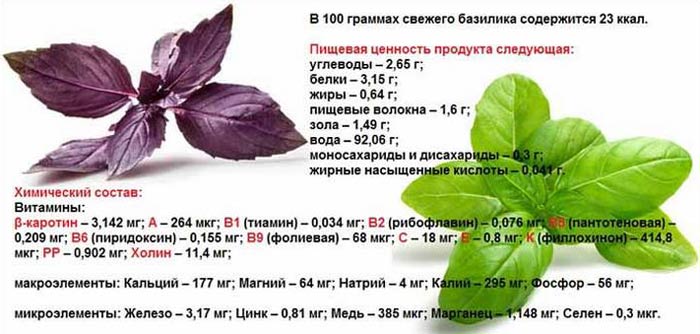
Basil varieties with green and purple leaves differ little in chemical composition.
Both types contain a large amount of nutrients:
- vitamin K (in 100 g - 887.2% of the daily requirement of the human body);
- C (25.7%);
- B5 (10.5%), B6 (37.4%), B9 (47.3%);
- beta-carotene is a precursor of vitamin A (63.8%);
- lutein and zeaxanthin - substances necessary for eye health (56.7%);
- omega-3 polyunsaturated fatty acids (32.0%);
- manganese (57.5%);
- cobalt (52.0%);
- copper (39.0%);
- iron (21.1%);
- calcium (16.1%);
- potassium (11.8%);
- silicon (15.3%).
The difference in the composition of one type of spice from another lies in the quantitative content of several components:
- Basil essential oil main substance - phenylpropanoid eugenol (antioxidant). Green varieties contain less of it than purple ones (67.4% versus 72.8%).
- Anthocyanins are colored pigments. There are much more of them in purple varieties, which determines their color.
In taste and aroma
Green basil is softer... The taste is gentle, even slightly sweet, with a slight refreshing aftertaste. The aroma is subtle, but depending on the variety, it can combine lemon, caramel, mint, clove notes.
Purple varieties are characterized by a sharp, tart, pungent taste and rich aroma. Pepper, clove, anise, nutmeg, cinnamon notes prevail.
In application
Due to the content of a large amount of aromatic substances, the leaves and stems of the plant are used fresh and dried as a seasoning for sauces, marinades, soups, salads, cold snacks, meat dishes, pickles.
Green basil with a mild flavor is more commonly used in European cuisine. It is especially popular in Italy, France, Greece, Bulgaria.
In addition to first and second courses, salads and snacks, it is often added to desserts, baked goods, beverages.
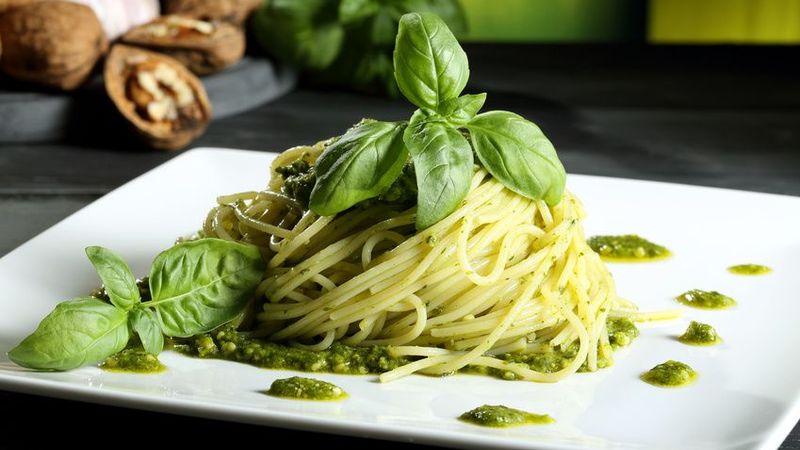
Purple basil is an essential spice in Asian and Caucasian cuisines. It goes well with meat, poultry, fish, vegetables, and is part of many sauces.
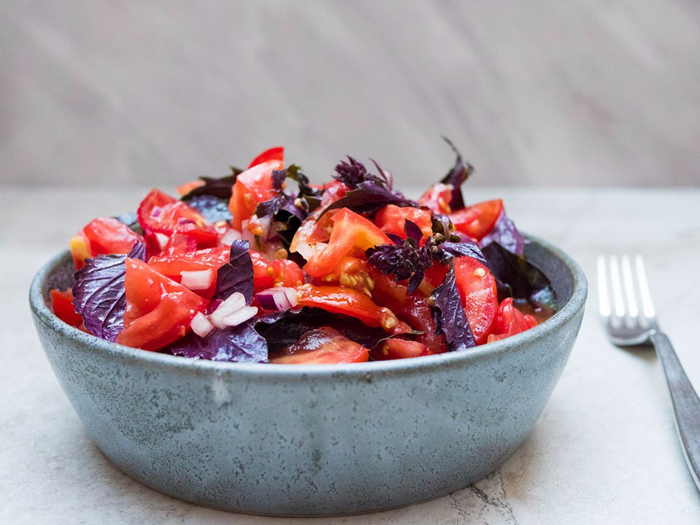
In cultivation
Differences in growing no green and purple basil.
The basic rules for growing both varieties outdoors are as follows:
- The landing site is well lit and protected from wind and drafts.
- The soil is not acidic, light, loose, rich in organic matter.
- Temperature - + 20 ... + 24 ° С.
- Watering: Basil loves moisture, but stagnant water should be avoided.
- Top dressing: basil planted in May requires a monthly top dressing, in June - 2 times (in early July and August). Nitrogen fertilizers are best suited.
- Undesirable neighborhood of other cultures with basil: dill, cucumbers, radish, radish.
- Good neighborhood: tomatoes, bell peppers, legumes.
Among varieties with green leaves, plants that are intended to be grown in pots are more common. This basil is compact, good foliage and small leaves.
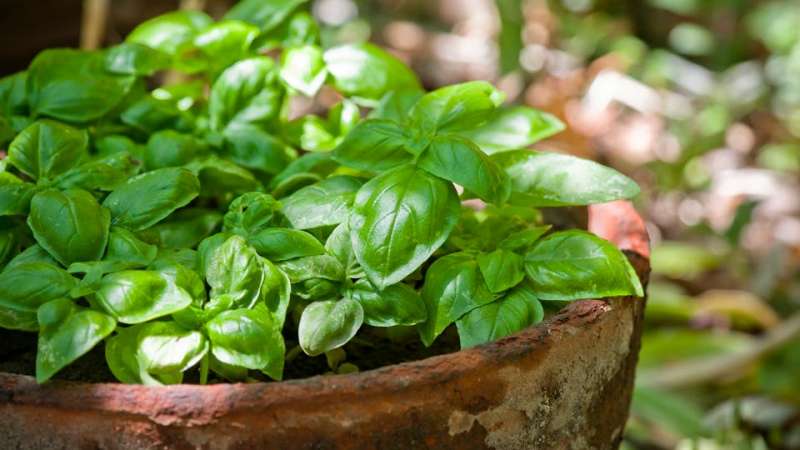
The benefits and harms of green and purple basil
Both varieties spices have a rich and almost identical chemical composition.
Useful properties for the human body:
- improving the functioning of the immune system;
- normalization of metabolic processes;
- improving the digestive system, intestinal motility, relieving spasms;
- elimination of inflammatory processes;
- providing antimicrobial action;
- improving the condition of the skin;
- strengthening bones;
- providing an antioxidant effect;
- normalization of the nervous system;
- lowering cholesterol and triglyceride levels in the blood;
- prevention of helminthiasis.
The plant, regardless of color, is contraindicated for use in the following cases:
- epilepsy;
- diseases of the cardiovascular system: heart attack, stroke, blood clotting disorders;
- diabetes;
- hypertension;
- individual intolerance.
For women during pregnancy and breastfeeding, it is better to limit the intake of basil.
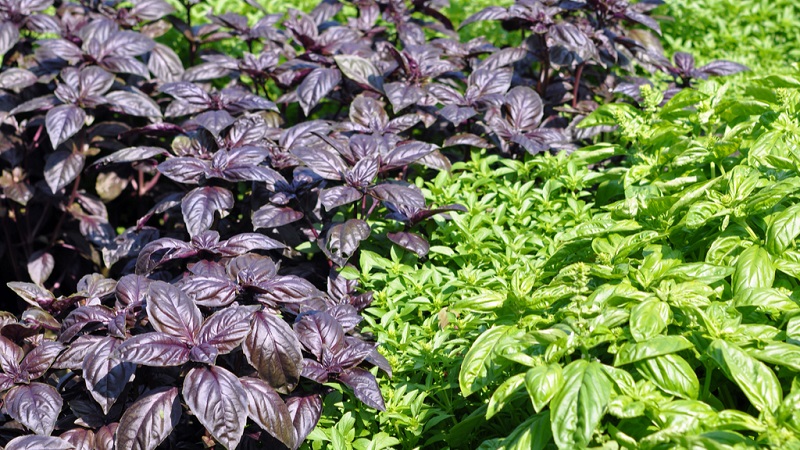
Which basil is healthier
Scientists are inclined to believe that purple basil is healthier than green. The reason for this is the presence in it of a large number of colored pigments - anthocyanins (cyanidin and peonidin), which provide the purple color of the plant. Green varieties are significantly inferior in the content of these substances.
Reference. Anthocyanins are organic compounds belonging to the flavonoid group. They are found in many plants and provide them with red, blue, purple color of fruits and leaves.
These substances have anti-inflammatory and pronounced antioxidant effects, helping to lower blood cholesterol levels.
Otherwise, green and purple varieties of basil in moderation are equally useful for the human body.
Is it possible to combine them in cooking
Green and purple basil are varieties of the same spice plant. Only purple is more intense and tart, while green has a delicate aroma and taste, which, depending on the variety, acquires lemon, mint, caramel shades.
You can combine green and purple basil. The taste of the dish will only benefit from this, because it will acquire a whole range of different tastes and aromatic notes of this plant. A variety of salads are considered an ideal basis for mixing two types of basil.
The best varieties of green basil
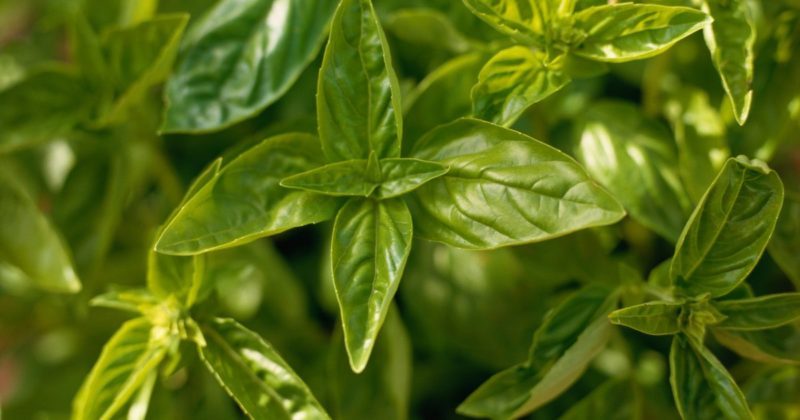
There are more than 150 varieties of basil that differ in taste and aroma.
The best varieties of green basil are considered to be:
- Basilisk - an early ripe variety. The height of the bush is 18-20 cm. The plant is compact with semi-raised shoots. Castings are small, green, oval, with a smooth surface. The flowers are white. The aroma is clove-pepper. Productivity - 0.6-0.7 kg / sq. m.
- Velvet - mid-season variety. Plant height - 25-30 cm. The leaf rosette is vertical. The leaves are dark green, elongated. The flowers are pink.Has a pleasant menthol aroma and flavor. Productivity - 1.9-2.0 kg / sq. m.
- Caramel - mid-season variety. The bush is small, spreading. Smooth leaves of medium size, dark green with a grayish tint. It has a strong specific aroma with hints of fruit caramel. Productivity - 2.7-3.3 kg / sq. m.
Of particular note is the Genoese (Italian) variety of basil, which is grown in temperate regions around the world. Plant height - 45-60 cm. The leaves are large, delicate with jagged edges, dark green.
Considered as the best option for Italian pesto.
Purple
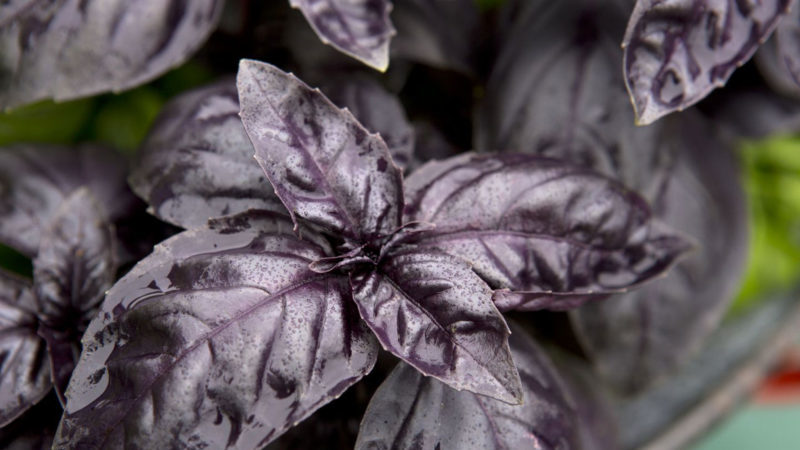
There are also a large number of varieties of purple basil.
The following varieties are distinguished:
- Opal - mid-season crop variety. A bush of medium height, erect. The leaves are medium in size with wavy edges, dark purple in color. The aroma is very strong, clove-peppery. Productivity - 1.1-1.2 kg / sq. m.
- Yerevan - mid-season variety. Medium sized bush with good foliage. The leaves are large, oval, dark purple in color. The leaf plate is smooth, without pronounced blistering. It has a strong aroma with hints of pepper and black tea, a tart taste. It is in demand among professional chefs. Productivity - 2.1-2.6 kg / sq. m.
- Ararat - mid-season culture. The plant is semi-spreading, 60 cm high. The leaves are purple, medium-sized, wide, oval in shape with a serrated edge. Strong aniseed aroma. Productivity - 2.0-2.4 kg / sq. m.
The varieties Violet, Dark Opal, Bakinsky, Delight, Red Ruby are also popular.
Conclusion
Basil is a spice with an intense aroma and original taste. It is widely used in cooking, especially popular in Europe, Asia, and the Caucasus. There are many varieties of basil, which can be roughly divided into green and purple.
The main difference between these 2 types is their taste and aroma. Green basil is distinguished by its tenderness and mildness of taste and aroma, violet - richness, astringency, pungency. The former is popular in European cuisine, the latter in Asian and Caucasian cuisine.